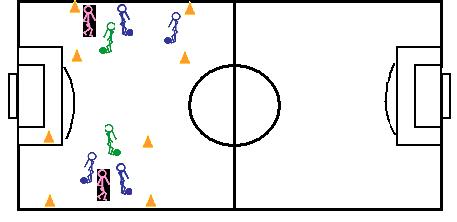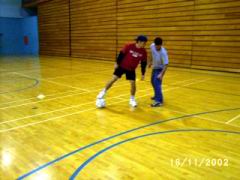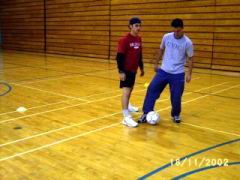Teaching Points:
-
Use both feet when dribbling.
-
Use of fakes and changes in direction are encouraged to help the student
elude the defender.
-
Shield the ball by using the body. Place body between ball and defender
OR attack straight on using fakes and changes in direction.
-
To maintain ball control, keep ball close to body and head up.
-
Use other players within the grid to help you escape any situations (i.e..
use another to cover you without them knowing that they are doing it, somewhat
like a screen).
|

The student who is "it" (the defender) must kick opponent's ball out
of grid. Once ball has been kicked out, that student joins the original
defender to form a 2 v 2 game, then 3 v 1, and so on.
 is the defender and is the defender and  is the pylon that forms the grid.
is the pylon that forms the grid. |
|
Organizational Points:
-
Depending on the class size, make sure the teacher sets up enough grids,
but not too many so that the teacher can not see all students at the same
time.
-
Adjust grid size accordingly to the succession rates of the students participating
within it. If the game is too easy for the students, then reduce the grid
size, making the space smaller and easier for the defender to clear out
balls. If students are having difficulty maintaining ball control, then
increase the grid size, so they have more room to practice and play.
-
In groups of four, one is automatically the defender, the other three are
trying to dribble and not get their ball kicked out of the grid. If ball
is kicked out, that students must join the other defender to help clear
out other soccer balls.
-
Once all the balls are cleared out, then the game is restarted with a different
defender. Rotate defenders after every game.
|
 
|

